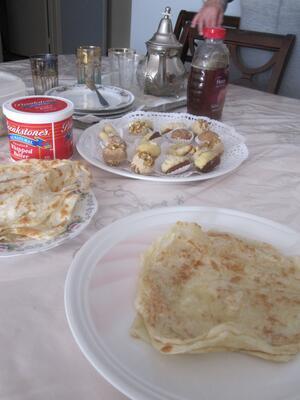Eating Jewish: Mufleta - Breaking Passover the Moroccan way
The way in which people choose to break Passover varies enormously and that first taste of chametz can be the non-traditional, but ever popular sushi, or something more rooted in Jewish culinary history like bagels. However, the Moroccan Jewish community ends Passover with a distinctive celebration known as the Mimouna.
This is a tradition that developed in Morocco, where on the afternoon of the last day of Passover, Muslim neighbors would bring gifts of flowers, milk, butter, honey, green beans, stalks of wheat and grains, and lettuce to the homes of their Jewish neighbors. Gil Marks explains that flour and starter dough would be included in this gift, and they would be used when preparing post-Passover chametz dishes for the Mimouna celebrations taking place later in the evening. Once Passover had ended, the Mimouna celebrations was a time for friendly relations between these two communities when Jews would open up their homes to both their Jewish and Muslim neighbors. An elaborate table would be laid which would include and dried fruits, nuts, various sweets, and cookies. However, the most popular dish served on this night is a thin yeast pancake called Mufleta, which is eaten spread with butter and honey.
This celebration was brought to the various places in which members of the community settled after emigrating from Morocco and it is now celebrated in places with large Moroccan Jewish communities such as Israel, France and Montreal. My own research involves examining the celebration of the Mimouna in Montreal as well as the food served on this night and through interviews I conducted with Moroccan Jews living in Montreal I came to find that the celebration of the Mimouna has taken on various meanings for the community in Canada. It has come to be a way for people to uphold a tradition that has been an ongoing part of this community for centuries and functions as a way for Moroccan Jews to preserve and display their Moroccan heritage in a landscape in which they have been the minority and have gone through a long and often difficult process of carving out their own place. Furthermore, the Mimouna is an important element in the maintenance of the social network of the community. More recently the Mimouna has also been a way for Ashkenazi Jews to learn about the rituals of the Moroccan Jewish community, with whom relations have not always been friendly.
The one thing the various people I interviewed agreed upon, no matter what their age, was that eating mufleta was their favorite part of the celebrations and the Mimouna simply wouldn’t be complete without it. Having only recently tried mufleta for the first time, I was blown away by how delicious they were and I couldn’t wait to make them in my own kitchen. Although they are usually prepared in a metal skillet, mufleta was originally cooked on earthenware griddles or on an inverted tangine. After being stretched so thin that they look like they may rip (a technique I still have to work on!), they are traditionally piled on top of each other in the skillet as they cook so that they remain soft and warm while others are being made. Due to the fact that they contain yeast, mufleta rises slightly and become lighter as they cook and are best served as soon as they come out of the pan. Although they take a few hours to prepare, they are definitely worth the effort and are a true Moroccan delicacy with which to break Passover.
Mufleta
From Gil Marks’ Encyclopedia of Jewish Food
1 package (2 ¼ teaspoons) active dry yeast or 1 (0.6 ounce) cake fresh yeast
1 ½ cups warm water (105°F to 115°F for dry yeast; 80°F to 85°F for fresh yeast)
1 teaspoon sugar or honey
2 teaspoons table salt or 4 teaspoons kosher salt
About 3 ¾ cups (18 ounces) unbleached all-purpose flour, or 2 cups (10 ounces) unbleached flour and 2 cups (12 ounces) fine semolina
About ½ cup vegetable oil for dipping
Melted butter for drizzling
Honey for drizzling
-
Dissolve the yeast in ¼ cup water. Stir in the sugar and let stand until foamy, 5 to 10 minutes. In a large bowl, combine the yeast mixture, remaining water, salt, and 2 cups flour. Gradually add enough remaining flour to make a supple dough slightly softer than regular bread dough. On a lightly floured surface, knead until smooth and elastic, about 10 minutes.
-
Divide the dough into 20 egg-sized balls or 40 small balls (half-eggs). The traditional way is to grab the mass of dough and squeeze the desired amount between a forefinger and thumb, them twist and pinch off the protruding ball. Dip and roll the balls in the oil to coat, place on a flat surface, and let stand for 30 minutes.
-
Heat an ungreased large cast-iron or nonstick skillet or griddle over medium heat.
-
On an oiled flat surface and using oiled hands, flatten the balls into 1/8 inch thick rounds. Cook the dough rounds until golden brown on the bottom, about 2 minutes. Turn and cook until golden and cooked through, about 1 minute. Cover the mufletas with a kitchen towel until serving to keep soft. Eat warm, drizzled with butter and honey, before the breads toughen.








The Mimouna holiday, which is most often associated with Moroccan Jews but is customary among many North African communities, has no specific halachot (laws). The customs, however, reflect the communityÌ¢âÂã¢s exuberant, joyful nature. Tables are decorated, often with symbols of luck and fertility (golden rings hidden in bowls of flour, items set out in sets of five, and sometimes live fish in bowls). Sweet delicacies (made of chametz) are served, particularly mofletta, a special pancake served with honey.Generally people wear their traditional costumes and yarmulkes .Historically it marks the start of spring and the permissibility of eating leavened products after their prohibition during the holiday. It is also popularly treated as a celebration of the Rambam, Rabbi Moses ben Maimon, the great medieval Torah luminary, for whom many say the festival is named.